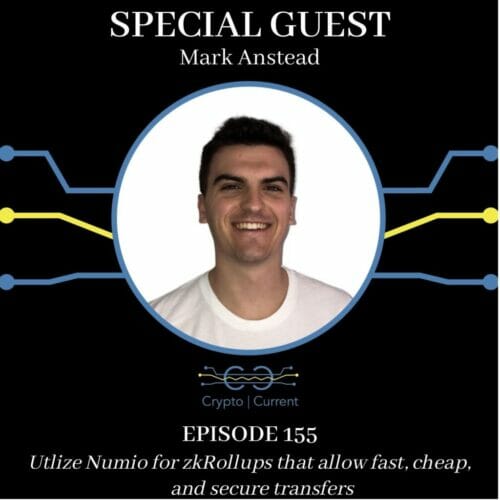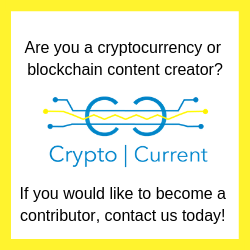Mark Anstead on Utlizing Numio’s zkRollups for Fast, Cheap, and Secure Transfers (Episode 155)
Mark Anstead joins us to discuss how you can utilize Numio for zkRollups that allow fast, cheap, and secure transfers.
Mark is the Co-Founder and Director of Business Development for Numio. 2x Founder, and is helping various teams in the Ethereum ecosystem, like PhoenixDAO, Uptrennd, and the Indexcoop.
Links:
Website: https://numio.one/
App: https://play.google.com/store/apps/details?id=com.numio.pay
Twitter: https://twitter.com/GetNumio
Personal Twitter: https://twitter.com/The_Shark_7
*Disclaimer. None of this information is financial advice.
The following transcript was created using artificial intelligence. There will be some grammatical errors below.
00:00:02:29 – 00:00:25:01
Richard Carthon: Hello, everyone. Welcome to another episode of Crypto Current, your host here, Richard Carthon, and today I got a special treat for you. We got a repeat guest. We have an OG. They came back on the show early, early in Crypto Current’s young career, back in episode 38. We have Mr. Mark Anstead now with a new company, Numio. How are you doing today?
00:00:25:19 – 00:00:41:22
Mark Anstead: It’s a pleasure to be back here. It’s kind of weird that I was one of the OG’s on the show and I’m glad to be back, excited to talk about what we’re working on. And hopefully I can shed some light.
00:00:43:04 – 00:00:57:09
Richard Carthon: Absolutely, I mean, a lot has happened since we’ve spoke, I believe, back in 2019. Just start with a little bit of background, give us a brief intro on who you are and what you’re doing.
00:00:57:11 – 00:01:51:01
Mark Anstead: For sure. Yeah, I’ve been in the Crypto space for a while now. I guess I bought my first Bitcoin back in 2014, started to get my hands dirty in 2017, 2018, working with a company called Cryptocurrency Investing Network. Then I decided I wanted to start actually like, working and building in the industry and not necessarily working with like, a wide variety of projects. So, I got involved with the project at the time called Hydro, created a company called Hydro Labs and built some really cool tech when I was there. And that sort of fizzled out, and more recently, I’ve started up a new company called Numio and we are focused on building out the user aggregation layer on Ethereum, focused on scaling Ethereum.
00:01:51:03 – 00:01:51:18
Richard Carthon: Yes.
00:01:51:24 – 00:01:54:03
Mark Anstead: Which is a huge problem going on right now.
00:01:55:11 – 00:02:00:27
Richard Carthon: Massive. I can’t wait for you to break this down. You’re going after a very needed and necessary topic.
00:02:01:23 – 00:02:45:17
Mark Anstead: Oh, yeah. It’s been really exciting because, like, I’m working with a few projects right now and really cool to help guide them through this whole, I don’t want to say mess, cause like Ethereum right now, it’s a mess, but I’m working with a few other open source projects like Phoenix, Dao, Index Coop, Uptrennd. And I mean, what’s going on in Ethereum, like it’s incredible, or I should just say, like watching in general. And I’m really excited to see where the next six to 12 months go. I have no clue what’s going to happen. I have an idea,
00:02:45:19 – 00:02:46:04
Richard Carthon: Yeah.
00:02:46:06 – 00:02:53:00
Mark Anstead: And I’ll share some ideas, but it’s going to be a wild ride and I’m strapped in for the roller coaster.
00:02:53:12 – 00:03:08:21
Richard Carthon: Hundred percent, man. Well, excited to dive into that. So, I want to address that you brought up Uptrend. So interestingly enough, Jeff Kirdeikis, who helped set that up, we had him on a show way back when. It’s cool to see Uptrennd continue to prosper, grow.
00:03:09:04 – 00:03:34:02
Richard Carthon: For everyone listening, you know that that’s also one of the places that we actually publish to regularly. If you’re not on there, definitely go check that out. But just wanted to drop that real quick since you brought it up. But going back to your earlier topic of Numio and the problem you are solving, scalability. So, let’s first for the newbies out there, explain that issue and then for everyone else who is very much aware of what’s going on, explain how Numio’s positioned to help solve that.
00:03:35:03 – 00:04:10:27
Mark Anstead: So right now, Ethereum is going through a massive, massive gas crisis. And when I refer to a gas crisis for you newbies and you’re like, what the heck does that mean? Like what’s going on with Exxon? What’s going on with all these gas companies? I’m not referring to gas that you put in your car, I’m referring to gas in the sense of fees that you have to pay to use a specific Blockchain network. And with Ethereum, it is exorbitant right now.
00:04:11:01 – 00:05:02:17
Mark Anstead: The prices to use the network are incredibly high and these fees only increase as you are doing additional computation. So, what I mean by that is when you’re interacting with a smart contract, it requires additional computation cost, so that requires more of a gas fee. So, let’s just say like sending a regular transaction, sending Eth, that’s going to charge about, it’s going to be about 21,000 gas, sending an Erc 20 token, it’s about 50 to 6,000 gas. And then, if we take into account for a Uniswap transaction, so like, making a trade, that just increases about to, I believe it’s 200,000 gas. Correct me if I’m wrong, I don’t remember what it is off the top of my head.
00:05:02:19 – 00:05:05:09
Richard Carthon: It’s a lot. It’s too much, it’s way too much.
00:05:06:09 – 00:06:37:18
Mark Anstead: The thing is, is about a year ago, making one of those trades was like pennies. It wasn’t that expensive, it’s just because the demand and the amount of people using the network wasn’t so high. And Ethereum, as it stands, is only able to process about 15 transactions per second, which with the millions of people that are using it right now, it is not able to scale. And to put it just straight up, if it was never able to scale, if it never scales, Ethereum will die because it will just become too expensive. The beauty of it right now though is the decentralization of it. So, it is the most powerful Blockchain network in the world. It is arguably the most decentralized Blockchain network in the world, specific to smart contract platforms, so, it needs to scale. So, there are a variety of ways that this can happen, you can say, “All right, screw Ethereum, I’m just going to move to an entirely different Blockchain,” which is what some people have done. They’ve moved to like Binance smart chain, they’ve moved to Near, Polkadot, or just a variety of different types of side chains. But a lot of people, when they’re looking at this, they’re like, I don’t want to do that, I want to stay on Ethereum because Ethereum is the most secure Blockchain in the world.
00:06:37:25 – 00:08:32:16
Mark Anstead: So, we need to scale Ethereum, and that is what Numio is helping to do. We launched the first mobile application on Google Play that supports a technology called ZK-Rollups. ZK-Rollups allows you to scale the Ethereum network without sacrificing any security of the Ethereum network because you have something called “on chain data availability.” So, all these transactions that are processing on this network, it’s called like a Layer Two network, all these transactions, they are still secured by the Ethereum network. So, if I’m sending a transaction on Layer Two, which costs 650 gas, right now like if Gwei is one hundred and Ethereum is $1,000, you’re going to be looking at a transaction costing about six and a half cents, which is dirt cheap. And you have all the security of the Ethereum main network when you’re conducting that transaction and this will allow you to essentially take all of the things that are going on with Ethereum specific to DeFi and scale those in an efficient manner. So, pretty much taking everything that you’re doing on the Ethereum main network and moving it into a scaled environment like a ZK-Rollup, the solution like that Numio is using. And you have all the security benefits, you have 2,000 transactions per second and your gas costs are going to be about one one hundredth of that of the Ethereum mainnet, which is, I mean, I’m not going to lie, it’s awesome.
00:08:32:25 – 00:09:09:23
Richard Carthon: It’s amazing. No, you’re selling the dream right now, like I need this yesterday. Like I mean, for everyone listening, especially the newbies and I know you were speaking on Gwei earlier and the stats. So, for example, I tried to convert one coin out of Eth into another one using Uniswap and the gas fee was $76 dollars. It cost me $76 to make whether it’s a $10 transaction or a $100 transaction, I was basically going to have to say, “Okay, how bad do I really want it?” And unfortunately for most people, that is not a cost analysis. It’s not worth it.
00:09:10:02 – 00:10:01:04
Richard Carthon: I mean, even if you’re spending a lot of money, it’s like, are you kidding me? Like, imagine if you went to the bank and you said, “Hey, bank, I want to go from the US dollar to the euro because I’m about to go overseas” and they’re like, All right, but it’s going to cost you $75 to do that. You’re going to look at them sideways, you’re like, are you kidding me? Like what? But unfortunately that’s where we are. And so, what it looks like Numio is solving that issue, especially with scalability. I mean, that’s amazing that it was only meant to do about 15 transactions in a second. That, first of all, that’s hilarious to me because I know there has to be like literally millions going on all the time and it looks like your protocol is basically able to go and help set that up. So, I mean, this sounds amazing. Where are you at on your roadmap? And like, how soon would someone be able to go and use Numio to like, instead of me paying these outrageous gas fees to start paying pennies?
00:10:02:20 – 00:10:56:23
Mark Anstead: Sure. So, right now, we’ve been live on Layer Two for about two months now. We have been, I don’t want to say we’ve been a little quiet over the last couple of months, but we’ve been very heads down getting focused for some very exciting things to come within the app and what we’re able to do on Layer Two, specifically like what you can do with like trading and things like that. So, right now within the app, you can do token transfers. So, you can go and you can send assets on Layer Two in a peer-to-peer manner, it could be $1, it could be a billion dollars and each one of those transactions, it’s just going to cost you pennines. It’s going to be dirt cheap, they’re completed instantly and it’s inexpensive and it’s awesome.
00:10:57:19 – 00:12:22:11
Mark Anstead: And what we are currently working on right now, which will be introduced in the next few weeks, so, definitely keep your eyes out, is the ability to trade on Layer Two through an automated market maker, similar to like, Uniswap. And this will allow you to make trades for, you guessed it, pennies. And the beauty about what is going to happen there is we’re able to take so much of the computation and break that down into just simple data that you can store in a Merkle tree and store that on the Ethereum network. Because the way that you’re doing a transaction currently on the Ethereum main network is, I don’t want to say there’s a lot of fat involved with each one of those transactions, but there’s a lot of fat that you’re spending in terms of a transaction fee and that gets significantly minimized on Layer Two. I believe the last time I checked, when you’re doing like a DeFi interaction, typically those costs are going down by like one one thousand. I believe that’s the number, I might be wrong. It’s somewhere between that and one one hundredth. But it’s going to be dropping a lot.
00:12:22:13 – 00:12:22:28
Richard Carthon: Right.
00:12:23:00 – 00:12:59:23
Mark Anstead: And it’s going to be awesome. And that will be coming in the next few weeks and once that’s live, it’s going to realistically be off to the races, because right now, like we’re the only mobile application that is running on TK Senkis, an implementation of a ZK-Rollup. So, we have a really awesome advantage right now like when you’re looking at this and like the competitive market to really take a big market share over, like, what’s going on in the Ethereum ecosystem.
00:12:59:25 – 00:13:18:26
Richard Carthon: Oh, absolutely. Oh, my gosh, like sorry to interject. But, like the amount of people that would flock to this in a heartbeat to say like, “Oh, instead of spending hundreds of dollars in gas, I can spend pennies or even dollars.” Like you’re telling me I can do all of this for under $5? People would freak out. It’s like, Yes, oh my gosh. That’s amazing.
00:13:19:16 – 00:13:38:10
Mark Anstead: Yeah. So, we’re working towards that right now. We’re in full steam ahead mode right now and working towards that. So, the next couple of months are going to be, they’re going to be pretty hectic and I’m very excited about it.
00:13:39:13 – 00:13:39:28
Richard Carthon: No doubt.
00:13:40:00 – 00:15:24:20
Mark Anstead: So, that’s something that you can definitely look forward to in the near future. I would say over the next few months, something that’s going to be introduced is pretty much creating our app into a fully functional financial product, because what’s going to occur with this Layer Two solution is it’s going to have something called EVM compatibility. If you don’t know what that means, EVM stands for the Ethereum virtual machine. This allows you to process, for example, smart contracts and different types of data on the Ethereum network. And you’re going to be able to process all of these existing contracts directly into this scaling solution. So, every existing solidity, smart contract is going to be able to move into this Layer Two scaling solution. So, everything that you do on Ethereum whether it’s like Aave, Compound, Uniswap, SushiSwap, all these solutions, they’re going to be able to be ported directly onto Layer Two and essentially all of the Ethereum ecosystem, all of like the Crypto economic activity is going to be moving on Layer Two. It’s going to be an interesting and exciting migration over the next six months and I’m pretty thrilled to sort of, I don’t want to say like being a part of like spearheading it.
00:15:24:22 – 00:15:25:07
Richard Carthon: Yeah.
00:15:25:09 – 00:16:05:14
Mark Anstead: But this is a huge moment in the future of DeFi because in its current form, DeFI is effectively dead. I don’t want to say it’s dead because like so much innovation is going on, but for 99 percent of people, if you’re operating Ethereum, they can’t and it needs to scale. And without these solutions, it won’t be able to. So, I’m really excited to be a part of that and bringing that into fruition.
00:16:06:03 – 00:16:48:09
Richard Carthon: We’re hearing a lot of good things from multiple speakers about Layer Two and how significant that is. And it’s interesting that you bring up like this moment in Crypto history just to show where everything’s headed. And there’s always references back to like the Internet, right? Of like where we are. And it feels like we’re going from like the super massive, like, super computer that’s like sitting in the back and you have to do a bunch of stuff to like do these simple computations to like your first personal computer, right? I feel like that’s kind of where we are on this trajectory. I feel like we’re still like a long way to go before like we really, really get it to that Internet boom and we’re still very early, but it feels like that’s that next step that we’re kind of headed towards and that’s exciting.
00:16:49:18 – 00:17:45:01
Richard Carthon: And like you said, like adding this scalability to Ethereum and showing how this would then work within like other ecosystems like it compounds into being able to have more interoperability, which I think is always one of the things that people need to be driving towards is like how do we get everything to communicate and be efficient and cost effective for people, right? So, you know, I’m excited for this, I’m excited for Numio and what y’all have going on with it, man. And just like you said, you kind of talked about Layer Two and how that’s going to come probably in the you know, next six months or so, but when you take a step back and you look at like where the market had started at the beginning of 2021 and where it looks like things are headed, what are some things outside of Layer Two that you are also looking at and have in the back of your mind?
00:17:47:07 – 00:19:20:21
Mark Anstead: I mean, one of the things that I would say that I’m worried about is 2021 seems like it’s going to become the next bubble for Crypto. Twenty seventeen was the ICO bubble and I think 2021 is going to become an NFT bubble. I think NFTs are freaking awesome, don’t get me wrong, Like I love NFTs, like I’ve aped into a few of these, like I’m not going to lie. Like they’re fun, they’re exciting, but I think that we’re going to see a little bit of a bubble in NFTs. So, be careful, be very smart about what you’re putting your money into because there’s probably going to be a little bit of a pop. There are going to be some NFTs that are unbelievably valuable, they will be incredibly successful and you will make an insane amount of money from them. But I would say similar to like, we saw with ICOs in 2017, probably 99 percent of them are going to turn out to be crap. So, just be aware of that and be careful, because coming from someone who, I mean, I put some money into ICOs back in 2017 and probably nine out of 10 went down like 99 percent or just like don’t exist anymore, so just be smart about that.
00:19:22:21 – 00:20:36:23
Mark Anstead: What I think will come out of that is it’ll show that NFTs are here to exist, they’re here to stay. What is so powerful about them is what you can do with like, smart contracts, how you can programmatically build different types of things into an NFT. So, let’s say you are a content creator, you don’t have to worry about your products getting resold. You can have that programmatically built in, so, if it gets resold, you still earn money and that’s something that’s going on with different types of marketplaces. One of the projects that I’m working with, Phoenix Dao, they’re releasing an event stat where you essentially are able to build NFTs in the form of a ticket. And you can essentially purchase tickets and if those tickets are able to get resold, you’ll then be able to make money off of those tickets. So, that sort of helps to combat some of the things that are going on, I guess, with like scalping and things like that.
00:20:36:25 – 00:20:37:10
Richard Carthon: Right.
00:20:37:12 – 00:20:57:09
Mark Anstead: I don’t know if that functionality is live yet in terms of like what’s being built into the smart contract. That’s something that they can work towards because those are things that you can build into a smart contract. And I think what it just proves is like, smart contracts, they’re fricking awesome.
00:20:57:11 – 00:20:57:26
Richard Carthon: Yeah.
00:20:57:28 – 00:21:41:04
Mark Anstead: Like, they are really cool and in the reality of things, the amount of innovation that we’re going to see over the next few years is going to just grow exponentially. Like what we saw with DeFi summer last year, like for people who weren’t in the weeds every single day, it was one of like the most euphoric and crazy, I would say, like three or four weeks of my life where I probably got, like, significant amount of gray hairs, like I made some money, which was awesome, but like things are just popping up left, right, and you don’t know what to do.
00:21:41:17 – 00:21:42:02
Richard Carthon: Right.
00:21:42:04 – 00:22:04:21
Mark Anstead: And the same thing is going to be occurring over the next couple of years. Like with all this innovation that’s going on, you think you’re going to be staying on top like, of everything? Good luck. You’re not because there is going to be some unbelievable innovation because you can just build on top of all of these different types of protocols and smart contracts and make them even more powerful.
00:22:05:18 – 00:22:59:12
Mark Anstead: So, it’s going to be a pretty wild next couple of years. I’m very excited, specifically about the DeFi market, like that’s my passion. I love it. I eat it, breathe and sleep it. I consider myself somewhat of a DeFi Degen. And I’m unbelievably excited about what that technology is going to bring for people around the world because we’re seeing a lot of people who are flocking to some of these solutions just because not necessarily like for using like Cryptocurrency as like an alternative asset, but using these as an alternative for growing their wealth and as a banking solution,
00:22:59:14 – 00:22:59:29
Richard Carthon: Yeah.
00:23:00:01 – 00:23:01:22
Mark Anstead: It’s really cool.
00:23:02:09 – 00:23:28:21
Richard Carthon: A lot of people are first time you know, banking the unbanked and then having a way to have some collateral that you can actually go get a loan on. And like, you know it’s there because literally you’re putting your Crypto in there. Like you’re literally giving people who ultimately either wouldn’t be able to get a loan or to create wealth or do some other things that you know, you’d have to have some initial assets or money to do in your traditional finance. You could do it in Crypto and it’s amazing.
00:23:29:14 – 00:24:13:26
Mark Anstead: Oh, yeah, it’s cool. I mean, I was working at a firm seven years ago, it was a firm, they sold life, health, disability insurance. There’s like a bunch of financial advisors and he called me up the other day, he’s like, Should I buy Bitcoin? And I was like, Oh, God, I don’t want to get into this conversation. But one of the things that we did talk about is how I’m able to generate APR yield on my funds.
00:24:14:19 – 00:24:15:04
Richard Carthon: Right.
00:24:15:06 – 00:24:26:21
Mark Anstead: I’m currently having a bunch of my US, I use USDC and I’m having that sit in a bunch of vaults. And obviously it’s a bull market, so those yields are significantly higher.
00:24:27:01 – 00:24:27:16
Richard Carthon: Yeah.
00:24:27:18 – 00:24:33:02
Mark Anstead: But even in a bear market, you’re generating at least five percent APR.
00:24:33:23 – 00:25:08:07
Richard Carthon: You can’t get that anywhere. Man, I’m sorry to interject. I always get excited about this and I tell people all the time, like, there’s no reason you shouldn’t be in Crypto because, like, if you have money that’s just sitting in a bank account making you .01 percent doing nothing for you, take that same money put in USDC and let it yield five to potentially eight, nine percent every year. And you’re going to get way more money, literally just letting your money sit, like just working smarter. Sorry to interject, but like dude, I am so passionate about that because, like, people are sleeping on these APY opportunities, this yield opportunity.
00:25:08:09 – 00:25:08:24
Mark Anstead: Yeah.
00:25:08:26 – 00:25:17:06
Richard Carthon: To literally just let your money sit and make money for you or even the fact you put money in like some of these staking opportunities, where your money is literally making you more money as well. Like, yes, it could go up and down with the market.
00:25:17:08 – 00:25:17:23
Mark Anstead: Woo, free money.
00:25:17:25 – 00:25:32:15
Richard Carthon: It’s truly free money. And it’s like how? I’m obviously passionate about this and I’m just like, you can work so much smarter with your money without having to work harder, just understanding that the opportunity is there and then acting on it.
00:25:33:10 – 00:25:47:22
Mark Anstead: I would say there are a few hurdles for it. One of which is education, which is like a big thing. The second is right now is like the gas fee problem.
00:25:47:24 – 00:25:48:09
Richard Carthon: Yeah.
00:25:48:11 – 00:26:39:22
Mark Anstead: Because like, let’s say I want to go and deposit into one of those vaults or let’s say I want to deposit into Compound, that’s like a $100 fee. And people are like, Screw that, I don’t have to do that. So, realistically right now, unless you’re putting in like a ton of money, it’s just not going to work too well. But obviously, like that’s why Ethereum’s scaling and, or working towards that. And the other thing that for me when I’m explaining this to people that like I would feel bad if I didn’t is having to say, “By the way, there is a risk when you’re putting your funds into the smart contract because, well, it’s a smart contract.”
00:26:39:24 – 00:27:59:09
Mark Anstead: And if there is a vulnerability in that smart contract, all of your funds could potentially be stolen because that is a risk when you’re dealing with any type of smart contract. Usually, like when I say that, people say, like “What, I don’t want to do that.” But obviously if they’re still interested and generally like many of them are, I say, “Well, okay, what you want to do is you want to look for some of these smart contracts and protocols that have at least like a billion dollars in total value locked.” Because what that means is all these hackers and coders around the world, they’ve been poking around into these smart contracts since their inception, trying to find bugs and figure out how to break into them and essentially steal that money. And for some of these major smart contracts, well, they haven’t or if they did, they found them very early on and they were exploited and fixed. And the fact that like, let’s say, for example, like Uniswap has, I don’t know what, like 10 billion dollars in total value locked down or like something insane.
00:27:59:11 – 00:28:00:25
Richard Carthon: Yeah.
00:28:00:27 – 00:28:49:27
Mark Anstead: In a year, it’s probably going to be like 50 to 100 billion. And like the reality of things is most likely there is no bug in there that your funds aren’t going to get stolen. And I think that’s like something that a lot of people just have to sort of realize because when you say like, Oh, like during like DeFi summer, it was like, Oh I was, I was firing a project and I was getting 10,000 APR. 10,000 percent APR and people are like, What is that? I was like, I don’t know, I was farming some random food coin. And then you get robbed or like the smart contract has a bug and then you lose all your money. But those are like, those are situations where it’s just a very early stake project.
00:28:50:05 – 00:29:16:20
Richard Carthon: Right. You know what you’re signing up for and like and what you’re describing, you’re more advanced Crypto persona is probably going to have a better understanding of the risk it is to like go and do that, but for your everyday person that’s just trying to get in and your front door is like Coinbase or something like that and you can literally just put it there, let it sit. If something happens to Coinbase, they’re FDIC insured. So like, you know you’re good for at least 250.
00:29:17:05 – 00:29:22:26
Mark Anstead: Not with Coinbase, only if it’s USD.
00:29:22:28 – 00:29:24:22
Richard Carthon: Oh, USD? Yeah.
00:29:24:24 – 00:30:15:08
Mark Anstead: Only if it’s USD, if you’re holding your Bitcoin, Ether, anything in there, that’s not insured. Like if you’re holding USD in there, yeah, that’s insured. But if you’re holding Crypto in Coinbase or Gemini or any of those institutions, if that gets stolen, it’s gone because the reason like, they’ll ensure like USD is because the fact they can go and print that. But if it’s like Bitcoin, Ether that gets stolen, can’t really do anything about that. And that’s why there’s insurance products, like Nexxus Mutual, Cover, things like that, that can help to potentially insure some people funds that are even being held on centralized products.
00:30:17:13 – 00:30:53:21
Richard Carthon: No, that’s good. I mean, that’s definitely something that everyone listening, good to know, even for myself, good educational moment right there. But that’s another good reason why you want cold storage and having other ways to protect your money as much as you can. But another thing, Mark, that I definitely wanted to bring up and ask you. One is, you’ve been in this space for a long time now and you’re constantly learning things. With all the knowledge that you’ve been able to gain over the last several years, if you go back to the very beginning when you were first starting this journey with all the knowledge you have today, what would you tell yourself?
00:30:59:21 – 00:31:53:06
Mark Anstead: Read more about projects and write about them. Because one of the things that I’ve found is like I’ve been writing a lot of content recently and when you write about something and you’re putting it on the paper or obviously you’re typing it, you begin to get a much better understanding of what the heck is actually going on, unless you’re like just kind of like free balling it. Like, when I’m writing something, I want to make sure everything that I’m saying is factually correct. And when I’m reading through something and I have to go back and I have to write about it, and it’s something like, fairly educational, it can be kind of difficult.
00:31:54:18 – 00:33:19:09
Mark Anstead: And I’ve definitely made some mistakes and have understood things in the wrong way over the last few years, which is expected. And like I would just say like to write more about like what I’m trying to learn about. And it’s beneficial for myself and more importantly, it’s helping other people to learn, because the reason that I’m here and like working in this space is because I’m passionate about it and because I want to help build and bring financial tools to more people, and a big part of that is education and helping to essentially teach people about what’s going on is really important. And a big portion of that comes through content creation, like yourself going and interviewing people or going and writing about things. There’s a lot of value in that. And that was one of the things that got me into Crypto. And God help me if I go back and read some of those original articles that I wrote, like, they’re awful, like terrible, like I hope they never reach the surface. But I didn’t really know what was going on when I first got in.
00:33:19:28 – 00:34:02:14
Richard Carthon: And did anyone? I mean, you learn, you learn through experience, but you have to throw yourself in the fire and just start. The whole point is that you started and that you started to get into it. And just like you said, I’m the same way. To write something down and try to put something on paper that, you know that someone else is going to read, you have to be thorough enough for it to make sense. And so, you want to be able to demonstrate your knowledge in a way that can be received by other people. And it also helps you know it for yourself and be able to speak to it a lot clearer. So, I do like that advice. You’re actually the first one to have said it that way. So, definitely thank you for that. Was there anything else that you wanted to add to that?
00:34:02:16 – 00:35:19:08
Mark Anstead: Crypto Twitter. Go on Crypto Twitter. Follow people on Twitter that are like, I don’t want to say, like thought leaders, but people that are like very outspoken in the ecosystem. You will learn more on Twitter than you will anywhere else and you’ll find out things first on Twitter than you will on any other news platform. I mean, that’s why they call it Crypto Twitter. You will learn so much. People joke about it sometimes, like how is this platform free? How is this free? But go on there, just follow what people are saying. And I wouldn’t say like, use money to like, invest in stuff that they’re talking about, maybe if you want to just like, throw money around and have a little bit of fun with it and just kind of like gamble money, but don’t expect anything to come from it. But just read and try to learn and learn from them, because there’s a lot of value and knowledge that’s shared for free. Absorb as much as you can.
00:35:21:24 – 00:35:59:14
Richard Carthon: That’s great advice. Man, Crypto Twitter is amazing. It’s a very well community, but also it can be kind of harsh as well if you ruffle the right feathers, but all the same, there’s a lot of free knowledge out there. There are some that if you want to take it to the next level and get a little bit further knowledge, you can pay a little bit. But all the same, like just get involved, get in part of the community. You meet a lot of great people who do genuinely want to help and are welcoming in to try to get you up to speed. So, thank you for that advice as well. But you know, thank you for everything that you’ve been able to share with us today. What is a final thought that you want to leave with all the listeners here today?
00:36:03:12 – 00:37:34:14
Mark Anstead: Blockchain is here to stay. Whatever you read on social media, whatever people say on Twitter or any type of news platform, if they say like Blockchain or one of these Blockchain’s is going to die, it’s probably not going to happen there. There’s so much innovation, so many intelligent people. You need to start learning about it and realize how it can be a part of your personal life and how it can benefit things that you’re doing, because believe it or not, something that you’re doing in your life, you can probably find some benefit from using some type of Blockchain based solution. Like, for me, I love DeFi, I think it’s awesome. Like if you’re a content creator, look into how you can monetize yourself as being a content creator, whether it’s like through creating content or building NFTs and creating a community around those types of things. There’s a lot of things, but it’s an awesome industry and it’s definitely here to stay. And I’m happy to be one of the, I guess early, I don’t know if you can call me an innovator.
00:37:34:16 – 00:37:35:01
Richard Carthon: I think it’s fair to say.
00:37:35:03 – 00:37:38:16
Mark Anstead: But one of the early sort of nerds.
00:37:39:07 – 00:38:00:03
Richard Carthon: Yeah, no, I would definitely say innovator, just like you said. You’re innovating right now and you’re helping Layer Two and helping to grow the Ethereum ecosystem and scalability and gas fees, oh my gosh. Numio, I’m looking forward to seeing what it does. Definitely going to check this out check. Everyone listening, definitely go check it out. What are some ways that people can connect with you and learn more about Numio?
00:38:01:10 – 00:39:32:06
Mark Anstead: Follow us on Twitter. Our handle is Get Numio. G-E-T N-U-M-I-O, Get Numio. You can follow us on Facebook, just search Numio. We are on Telegram as well. We have a channel, search for Numio and we have a Telegram channel there. If you want to follow me on Twitter, my handle is The_Shark_Seven, The Shark Seven. If you want, download our app. If you want to reach out to me, like say that you listened to me speaking on Crypto Current and I downloaded the Numio app and say hello and you know what, I’ll send you some Crypto on the app and let you test drive it and have some fun. We are on Android right now. We will soon be on iOS, thankfully. I’m an IOS born and raised and I’ve been using this clunky piece of crap. So, I’m looking forward to getting back to my iOS. If you do have an Android, download it and let us know what you think. Feel free to rip it apart, give us some feedback and most importantly, I’ll send you over some Crypto and have some fun with the app.
00:39:32:24 – 00:39:41:00
Richard Carthon: Awesome. Well, thank you so much for that, Mark. Everyone listening, make sure you go check it out and hit him up so you get some free Crypto. And of course, for everyone listening, Stay Crypto Current.

Crypto Current will be guiding all of you who are new to the cryptocurrency world to becoming a cryptocurrency and blockchain expert.










